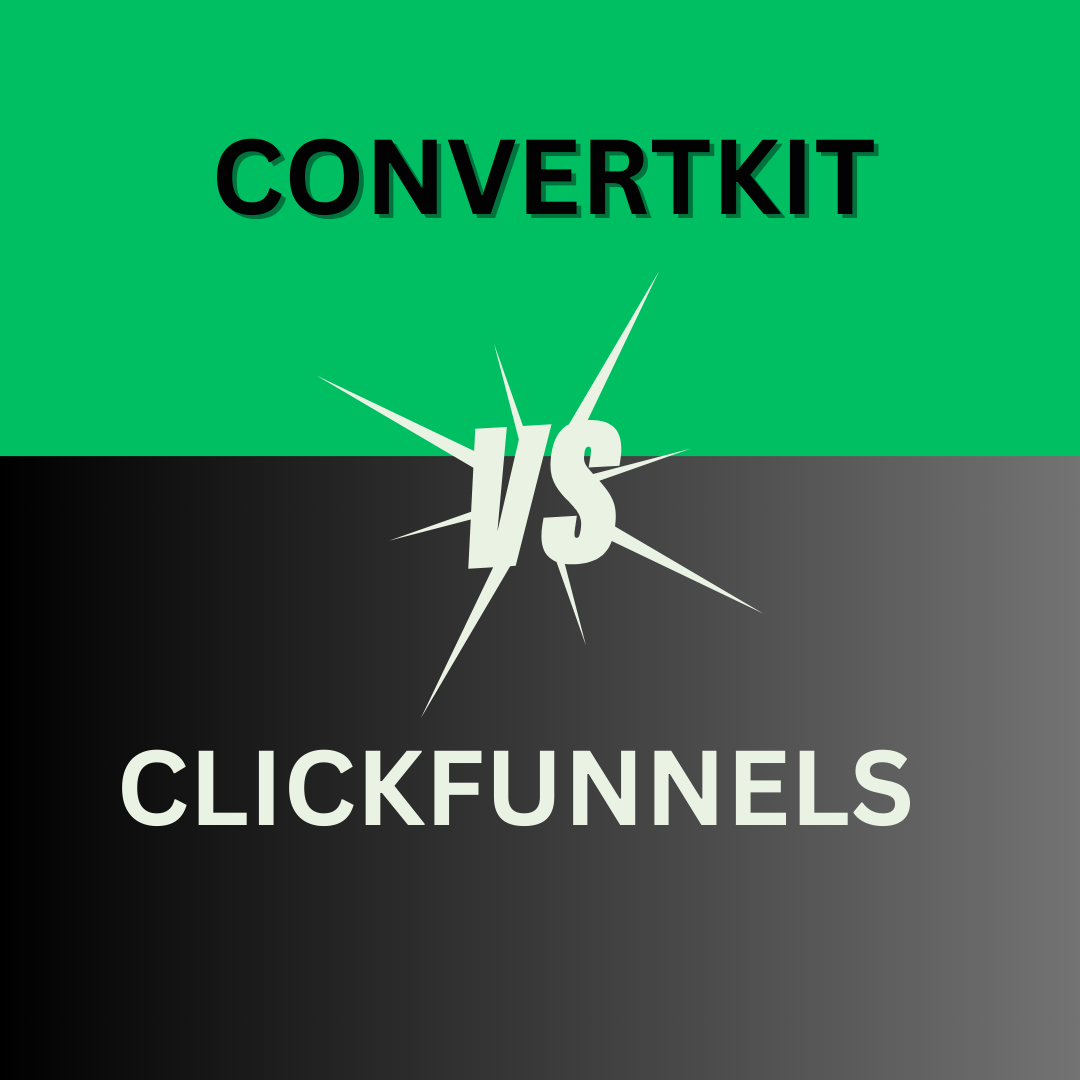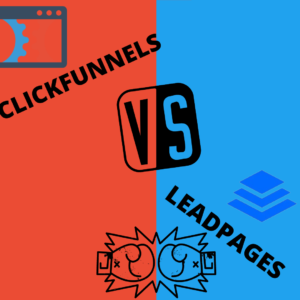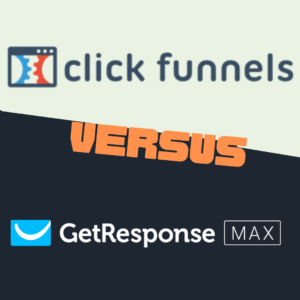In this comprehensive guide, we dive deep into the “ConvertKit vs ClickFunnels” debate to help you decide which platform is best suited for your marketing needs. Whether you’re a content creator looking to grow your audience through targeted email campaigns or a business owner aiming to increase sales with optimized funnels, understanding the key differences between these two powerful tools is crucial. We’ll explore various aspects, including email marketing capabilities, sales funnel creation, ease of use, pricing, and more, to provide you with the insights needed to make an informed decision. Join us as we unravel the strengths and weaknesses of ConvertKit and ClickFunnels, guiding you towards the right choice for your digital marketing strategy.
Table of Contents
ConvertKit vs ClickFunnels Round 1 -Email Marketing Capabilities
When comparing the email marketing capabilities of ConvertKit vs ClickFunnels, it’s essential to understand how each platform caters to the needs of digital marketers and entrepreneurs looking to optimize their email marketing strategies.
ConvertKit Email Marketing Capabilities
ConvertKit is designed with creators in mind, offering a suite of email marketing tools that are both powerful and user-friendly. Its capabilities include customizable email templates, allowing users to design visually appealing emails without needing extensive design skills. ConvertKit’s strength lies in its automation features, which enable users to set up complex email sequences triggered by subscriber actions, ensuring timely and relevant communication with their audience.
Segmentation is another area where ConvertKit shines. Users can easily segment their subscribers based on various criteria, such as engagement level, purchase history, or interests, allowing for highly targeted and effective email campaigns. This segmentation helps in delivering personalized content that resonates with each segment, potentially increasing conversion rates.
ClickFunnels Email Marketing Capabilities
While ClickFunnels is primarily known for its sales funnel creation tools, it also offers robust email marketing features through its Etison Suite plan, which includes Actionetics. This built-in email service provider allows users to create email sequences, broadcast emails, and implement tagging based on user behavior. However, it’s worth noting that to leverage these email marketing capabilities, users must subscribe to the platform’s higher-tier plan.
ClickFunnels focuses on integrating email marketing with sales funnels, providing a seamless transition from lead capture to conversion. The platform enables users to automate follow-up sequences, deliver targeted messages at each funnel stage, and ultimately drive sales through direct email marketing efforts.
ConvertKit vs ClickFunnels Round 2 -Sales Funnel Creation
When comparing ConvertKit vs ClickFunnels in the realm of sales funnel creation, it’s essential to understand how each platform caters to the diverse needs of digital marketers and entrepreneurs. Here’s a breakdown of how both platforms perform in sales funnel creation, presented in an informative, concise, and easy-to-understand manner.
ClickFunnels is designed with a primary focus on building highly effective sales funnels. It offers users a range of pre-built funnel templates that cater to various business needs, such as product launches, webinars, and lead generation. The drag-and-drop interface allows for easy customization of each funnel stage, from the landing page to the thank you page, without needing extensive technical knowledge. ClickFunnels excels in creating a seamless flow that guides visitors through the buying process, incorporating upsells, downsells, and order bumps to maximize revenue. The platform’s strength lies in its ability to create a cohesive journey that converts visitors into customers and maximizes the value of each conversion.

ConvertKit, on the other hand, is primarily an email marketing tool designed to help creators grow and engage their audience. While not built specifically for sales funnel creation, ConvertKit offers automation features that can be used to create a basic sales funnel. Users can design email sequences that nurture leads by delivering targeted content and promotions at optimal times. ConvertKit’s focus is on building and maintaining a relationship with your audience, making it a powerful tool for the email marketing aspect of your sales funnel. However, when it comes to the broader scope of funnel creation, including landing pages and payment processing, ConvertKit might require integration with other tools to achieve the same level of functionality as ClickFunnels.
ConvertKit vs ClickFunnels Round 3 -Landing Page Builder
When evaluating “convertkit vs clickfunnels” in terms of their landing page builder capabilities, it’s essential to understand the distinct functionalities and user experiences each platform offers. Landing pages are crucial in digital marketing, serving as the first impression and conversion point for your audience.
ConvertKit
ConvertKit simplifies the landing page creation process for creators and entrepreneurs focusing on building their audience. With ConvertKit, users have access to a straightforward editor that allows for quick modifications and the integration of essential elements like forms and CTAs (Call to Action). Although it offers fewer templates than ClickFunnels, ConvertKit’s templates are beautifully designed and highly optimized for conversions, especially for those in the content creation and digital product spaces.
ClickFunnels
ClickFunnels, on the other hand, is a powerhouse for creating sales-driven landing pages. It offers a wide array of customizable templates designed to cater to various sales funnels, from webinars to product launches. The drag-and-drop editor provides a more detailed customization experience, making it suitable for users who require more flexibility and functionality in their landing page design. ClickFunnels excels in creating landing pages that are part of a broader sales funnel strategy, offering advanced features like A/B testing and conversion rate analytics.
ConvertKit vs ClickFunnels Round 4 -Integration and Compatibility
When comparing ConvertKit vs ClickFunnels in terms of integration and compatibility, it’s essential to understand how each platform connects with other software and services. This compatibility is crucial for marketers and business owners looking to streamline their operations by integrating their email marketing or sales funnel software with other tools they use.
ConvertKit is renowned for its focus on creators and bloggers, offering seamless integration with over 80 popular tools and platforms. These include e-commerce platforms like Shopify and WooCommerce, membership site platforms such as Teachable and Memberful, and lead capture tools like LeadPages and Unbounce. ConvertKit’s API also allows for custom integrations, making it highly adaptable to your specific business needs. This flexibility is a significant advantage for users who rely on a variety of tools to manage their online presence and sales.
ClickFunnels, on the other hand, excels in building sales funnels and offers a wide range of integrations specifically designed to optimize the sales process. It integrates with major email service providers, webinar platforms, payment gateways (such as PayPal and Stripe), and CRM systems like Salesforce. ClickFunnels’ integrations are geared towards automating the sales funnel from lead capture to final sale, ensuring a smooth workflow for businesses focused on maximizing their conversion rates.
When choosing between ConvertKit and ClickFunnels based on integration and compatibility, consider the tools and services you currently use or plan to use. If your focus is on email marketing and content creation, ConvertKit’s broad range of integrations with content management and e-commerce platforms may be more beneficial. However, if your primary goal is to create optimized sales funnels that include payment processing and customer relationship management, ClickFunnels might be the better fit.
ConvertKit vs ClickFunnels Round 5 – E-commerce Capabilities
When comparing ConvertKit vs ClickFunnels, particularly in terms of e-commerce capabilities, it’s important to recognize that each platform serves different primary functions with some overlap in e-commerce features.
ClickFunnels is designed primarily to create sales funnels that convert visitors into customers. Its e-commerce capabilities are robust, allowing users to easily design and implement sales pages, product launch funnels, and checkout processes. With ClickFunnels, you can sell both digital and physical products, set up payment gateways (like PayPal and Stripe), and manage your entire sales process in one place. The platform also supports order bumps, upsells, and downsells, increasing the average order value per customer. For businesses focused on maximizing sales through funnels, ClickFunnels offers comprehensive tools that make it easy to scale.
ConvertKit, on the other hand, is primarily an email marketing tool designed for creators. Its e-commerce capabilities are more limited but still effective for certain use cases. ConvertKit allows you to sell digital products and subscriptions directly through email broadcasts and landing pages. While it doesn’t offer the extensive sales funnel features of ClickFunnels, ConvertKit makes it straightforward for creators to monetize their audience without needing a separate e-commerce platform. It’s particularly useful for selling ebooks, courses, and access to exclusive content.
ConvertKit vs ClickFunnels Round 6 – Automation and Workflows
When comparing ConvertKit vs ClickFunnels in the context of automation and workflows, it’s essential to understand how each platform caters to automating marketing and sales processes, a critical factor for businesses looking to scale efficiently.
ConvertKit shines with its user-friendly approach to email automation. It allows users to create sophisticated email sequences based on subscriber actions, making it a powerful tool for bloggers, content creators, and small businesses focused on building and nurturing their email lists. ConvertKit’s visual automation builder lets you easily design complex email workflows, ensuring the right message reaches the right subscriber at the right time. This feature is particularly beneficial for those looking to automate their email marketing without getting bogged down in technical details.
ClickFunnels, on the other hand, excels in automating the sales funnel process from start to finish. It’s not just about emails; ClickFunnels provides a comprehensive suite of tools to build automated sales funnels that guide potential customers through a predetermined journey. From landing pages to upsell pages and payment processing, ClickFunnels automates nearly every aspect of the sales funnel. This level of automation is ideal for entrepreneurs, marketers, and businesses that sell products or services online and want to optimize their sales process for higher conversions.
ConvertKit vs ClickFunnels Round 7 -Analytics and Reporting
When comparing ConvertKit vs ClickFunnels in terms of analytics and reporting capabilities, it’s essential to understand how each platform enables users to track performance and measure success against their marketing goals.
ConvertKit Analytics: ConvertKit offers a straightforward analytics dashboard that focuses primarily on email marketing metrics. Users can easily track open rates, click rates, subscriber growth over time, and the performance of individual email campaigns. ConvertKit’s simplicity in analytics is perfect for content creators and marketers who prioritize email engagement and audience growth. The platform also provides insights into how well subscribers respond to different email sequences, which can be invaluable for refining your email marketing strategy.
ClickFunnels Analytics: ClickFunnels, on the other hand, offers a more comprehensive analytics suite designed to track the performance of sales funnels. Users can monitor page views, opt-in rates, conversion rates, and sales data across their funnel stages. This level of detail is crucial for businesses focused on optimizing their sales processes and increasing conversion rates. Additionally, ClickFunnels integrates with external analytics tools like Google Analytics for even deeper insights, allowing users to track the customer journey end-to-end.
ConvertKit vs ClickFunnels Round 8 – Customer Support and Community
When comparing ConvertKit and ClickFunnels, particularly in terms of customer support and community, it’s essential to consider how each platform stands out in providing assistance and fostering a supportive user environment. Both platforms aim to ensure their users succeed, but they do so in slightly different ways.
ConvertKit prides itself on offering robust customer support, with a team readily available through email. They are known for their quick response times and the personalized attention they provide to each query. ConvertKit also offers a comprehensive knowledge base filled with articles, tutorials, and guides designed to help users navigate and maximize the platform’s capabilities. The ConvertKit community is vibrant and engaging, with a significant presence on social media and forums where users can share tips, strategies, and support one another. ConvertKit frequently hosts webinars and live Q&A sessions, providing users with direct access to experts for their immediate concerns.
ClickFunnels, on the other hand, boasts an extensive array of support resources. Their customer service includes email support, live chat, and even phone support, ensuring that users can reach out through their preferred channel. ClickFunnels excels in offering a rich ecosystem of educational content, including a vast library of tutorials, documentation, and video guides that cover every aspect of using the platform. The ClickFunnels community is one of the most dynamic aspects of the platform, with a highly active Facebook group that has hundreds of thousands of members. This community serves as a hub for users to exchange advice, strategies, and success stories, creating a motivational environment for both new and experienced marketers.
ConvertKit vs ClickFunnels Round 9 – Pricing and Plans
Choosing between ConvertKit and ClickFunnels often comes down to understanding their pricing and plans. Both platforms offer a range of options tailored to different needs, from beginners to large enterprises. Let’s break down the “convertkit vs clickfunnels” pricing to see which might suit your budget and requirements better.
ConvertKit Pricing
ConvertKit offers a simple and transparent pricing model based on the number of subscribers. They provide a free plan and several paid tiers which include:
- Free Plan: Designed for up to 1,000 subscribers, offering basic features such as email broadcasts, forms, and landing pages.
- Creator Plan: Starting at $25/month for up to 1,000 subscribers, this plan introduces automation and third-party integrations.
- Creator Pro Plan: Starting at $50/month, adding advanced features like subscriber scoring and advanced reporting.
ConvertKit’s pricing scales with your subscriber count, so as your list grows, so does the cost. However, all plans allow for unlimited emails, which is a significant advantage for heavy email marketers.
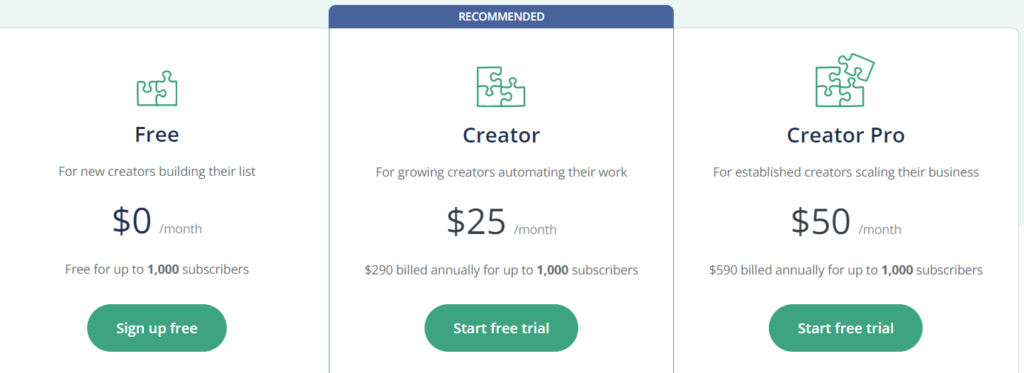
ClickFunnels Pricing
ClickFunnels, focusing on creating sales funnels and landing pages, has a different pricing approach. Their plans include:
- Standard Plan: At $97/month, offering up to 20 funnels, 100 pages, and 1 user account. It includes all the basic funnel-building tools.
- Platinum Plan: At $297/month, you get unlimited funnels, pages, and 3 user accounts, along with access to additional features like affiliate management and email marketing tools.
- TwoCommaClubX Plan: Designed for enterprise-level needs, pricing is available upon request and includes all ClickFunnels features at scale.
ClickFunnels plans are feature-based, with the main difference being the number of funnels and pages you can create and access to advanced functionalities.
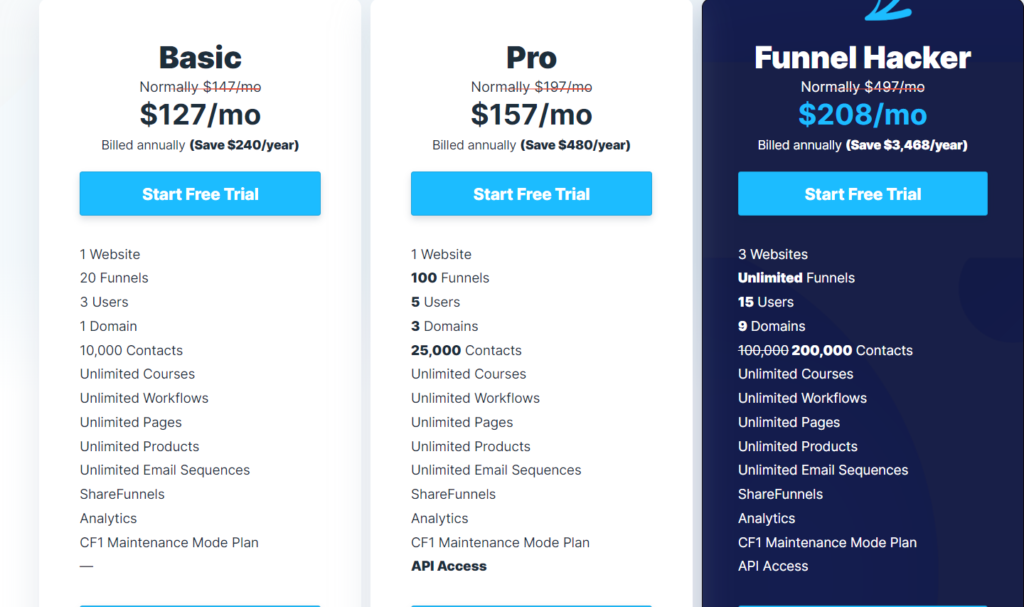
ConvertKit vs ClickFunnels Final Round -Pros and Cons
When comparing ConvertKit vs ClickFunnels, it’s essential to weigh the pros and cons of each platform to understand which one aligns best with your marketing goals. This section will highlight the strengths and weaknesses of both platforms, using the focus keyword to ensure SEO optimization.
ConvertKit Pros:
- User-Friendly Interface: ConvertKit offers a straightforward and intuitive interface, making it easy for beginners to navigate and set up their email marketing campaigns.
- Powerful Email Marketing Tools: Specializes in email automation and segmentation, allowing for personalized email campaigns that can significantly improve engagement rates.
- High Deliverability Rates: Known for its excellent email deliverability, ensuring that your emails reach your subscribers’ inboxes.
- Creator-Friendly: Tailored for bloggers, podcasters, and other content creators, providing features like landing pages and sign-up forms to help grow their audience.
ConvertKit Cons:
- Limited Sales Funnel Features: Compared to ClickFunnels, ConvertKit offers fewer features for creating and managing sales funnels.
- E-commerce Capabilities: While improving, its e-commerce features are not as robust as ClickFunnels, making it less ideal for businesses focused on online sales.
ClickFunnels Pros:
- Comprehensive Sales Funnel Builder: Excelling in creating detailed and effective sales funnels, ClickFunnels is the go-to for businesses looking to optimize their sales process.
- All-in-One Platform: Offers a wide range of features including landing pages, payment processing, and webinar hosting, making it a versatile tool for online businesses.
- A/B Testing: Easy to use A/B testing for landing pages and sales funnels, helping users optimize their strategies for better conversion rates.
- Strong Community and Support: Benefits from a large, active community and extensive training resources, aiding users in maximizing their use of the platform.
ClickFunnels Cons:
- Pricing: It’s generally more expensive than ConvertKit, which might be a significant consideration for startups and small businesses.
- Complexity: With its extensive features, there’s a steeper learning curve, potentially overwhelming for new users or those with simpler needs.
Conclusion
In conclusion, the decision between ConvertKit vs ClickFunnels ultimately depends on your specific business needs and marketing goals. ConvertKit shines as an email marketing platform, offering simplicity, efficiency, and high deliverability rates, making it an excellent choice for content creators and marketers focused on growing their audience through email engagement. Its user-friendly interface and creator-focused features support those who prioritize direct communication with their audience.
On the other hand, ClickFunnels stands out as a comprehensive sales funnel builder, designed to guide users through the entire sales process from awareness to purchase. Its all-in-one approach to landing pages, sales funnels, and e-commerce capabilities makes it a robust tool for businesses looking to optimize their online sales processes. Although it comes at a higher price and with a steeper learning curve, the investment can be well worth it for businesses focused on maximizing conversions and sales.
When choosing between ConvertKit and ClickFunnels, consider your primary focus: if email marketing is your main channel for audience engagement and growth, ConvertKit may be the better fit. However, if you’re looking to build and optimize sales funnels to increase conversions and sales, ClickFunnels could offer more of the functionalities you need.
Ultimately, both platforms offer valuable features that can significantly impact your digital marketing strategy. By carefully considering the pros and cons of ConvertKit vs ClickFunnels, you can select the tool that best aligns with your marketing objectives, ensuring that your efforts lead to meaningful engagement and growth for your business.


